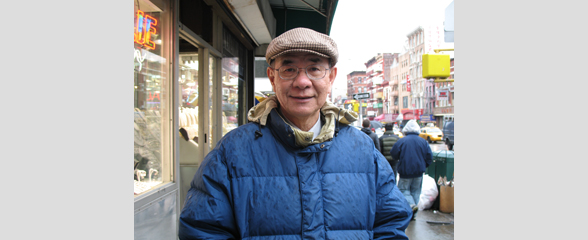Chinese American gangs

2008.040.015 Oral History Interview with Kam Mak March 6, 2008
Kam Mak is an artist who emigrated with his parents from Hong Kong to the United States at age ten in 1971. In this interview, he vividly describes growing up in an old tenement building on Eldridge Street and becoming involved with street kids during the seventies. He mentions the strong presence of street gangs during his childhood as well as the turning point during his youth that redirected him towards art as an escape from getting into trouble. Mak also discusses conceptual ideas that inspire his artwork, which is heavily influenced by his sensory impressions of the Chinatown neighborhood and culture. He notes the changes in neighborhood dynamic since then, observing differences in population, safety, and lifestyle. After moving out of Chinatown in the early 90s, Maks art became a means to reconnect or save his ties to the Chinatown community. He goes on to describe his work writing and illustrating his childrens book My Chinatown and designing a series of Lunar New Year stamps for the U.S. Postal Service. Reflecting on how Chinatown’s identity is rooted in its low-income and immigrant residents, he laments about how the forces of gentrification could eventually erode Chinatown to a “fake†shell of its former glory.

2008.040.019 Oral History Interview with Ho Ying Pang March 16, 2008
Pang Ho Ying was born in Taishan, China, but grew up and spent a large portion of his life in Hong Kong until he moved to New York with his wife in 1988. Interestingly, his family was divided on both the East and West coasts: he and his two brothers settled in New York, while his two sisters moved to San Francisco. Pang vaguely remembers his first impression of New York upon his arrival as relatively less modern than Hong Kong, claiming that Chinatown appeared backwards since it lacked the modern buildings and technology of Hong Kong. Regardless, Pang perceived Chinatown as a friendly and supportive environment that deeply valued family relationships and friendships.
Though Pang did not plan or arrange employment in the United States before immigrating, he trusted he would find a suitable job. After two months, he found work through his younger brother as a general handyman or “gofer†at the Music Palace theater. Pang eventually became the director of the theater and managed the daily operations until he retired. In his interview, Pang walks through the history of the Music Palace and offers his opinions on what ultimately brought about the movie theater’s demise in 2000. Pang asserts that the reason the theater went out of business was because it was no longer in demand after the popularization of the relatively cheaper videotape rental. As the theater began running deficits and attendance records started dwindling, Pang recommended to the Hong Kong based theater owners that the business close its doors, bringing an end to the last movie theater that specialized in Hong Kong cinema in the United States. Pang recognizes the pragmatic reasons for closing the Music Palace but still expresses regret that the theater could no longer serve as a community gathering place for residents and visitors alike.
Pang goes on to identify some of the changes that he has witnessed in Chinatown more broadly, particularly that many old buildings had been upgraded and renovated, empty and vacant lots had gradually been built up, rent prices had skyrocketed, and the general aesthetics of the neighborhood had improved. He also hints at a generational shift and ethnic tension, comparing the new wave of Fukienese immigrants with the older generation of mainland Chinese immigrants to the neighborhood. While Pang notes that his children do not desire to return to Chinatown, he still explains that he hopes to remain living in Chinatown because of its convenient location, the Chinese food and tea, and general familiarity.